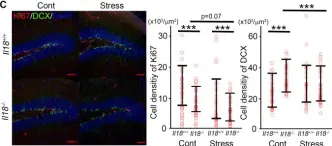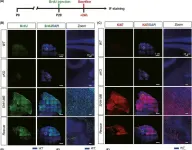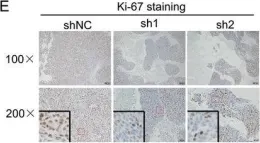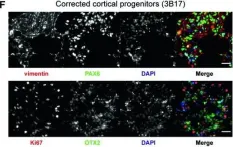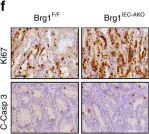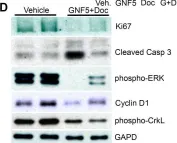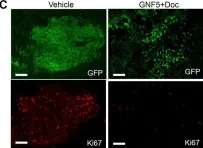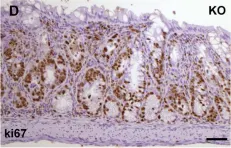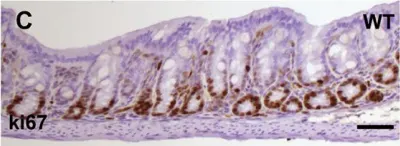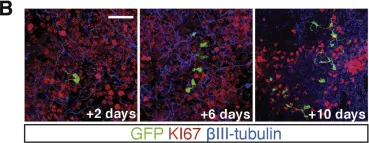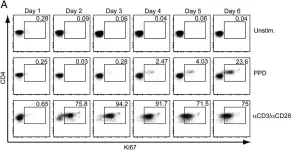Quiescent neural stem cells (qNSCs) in the adult mouse subventricular zone (SVZ) normally have limited capacity to generate glia. Gliogenic domains are present in both dorsal and ventral SVZ, with the ventral region featuring a subpopulation of Gli1+ qNSCs. In dorsal SVZ, however, the molecular identity and developmental origin of oligodendrogenic qNSCs remains elusive. Here, through single-cell analysis and lineage tracing, we identify an undefined subpopulation of Gas1high qNSCs in dorsal SVZ, distinct from Gli1+ qNSCs. These cells originate from embryonic Gas1high dorsal radial glia, and persist into the aged SVZ. Remarkably, they are multipotent and more gliogenic than Gas1low/- qNSCs, continuously generating oligodendrocytes in the adult and aged brain, and can be mobilized for myelin repair upon demyelination. Together, our study uncovers a subpopulation of dorsally derived, multipotent long-term qNSCs in the adult and aged SVZ with enhanced gliogenic potential, shedding light on the heterogeneity and plasticity of NSCs in normal, aging, and disease conditions.
Copyright: © 2025 Ding et al. This is an open access article distributed under the terms of the Creative Commons Attribution License, which permits unrestricted use, distribution, and reproduction in any medium, provided the original author and source are credited.
Product Citations: 864
In PLoS Biology on 1 April 2025 by Ding, C., Pan, Z., et al.
-
Neuroscience
-
Stem Cells and Developmental Biology
In NPJ Parkinson's Disease on 31 March 2025 by Žagare, A., Balaur, I., et al.
Parkinson's disease (PD) is a progressive neurodegenerative disorder with no effective treatment. Advances in neuroscience and systems biomedicine now enable the use of complex patient-specific in vitro disease models and cutting-edge computational tools for data integration, enhancing our understanding of complex PD mechanisms. To explore common biomedical features across monogenic PD forms, we developed a knowledge graph (KG) by integrating previously published high-content imaging and RNA sequencing data of PD patient-specific midbrain organoids harbouring LRRK2-G2019S, SNCA triplication, GBA-N370S or MIRO1-R272Q mutations with publicly available biological data. Furthermore, we generated a single-cell RNA sequencing dataset of midbrain organoids derived from idiopathic PD patients (IPD) to stratify IPD patients within the spectrum of monogenic forms of PD. Despite the high degree of PD heterogeneity, we found that common transcriptomic dysregulation in monogenic PD forms is reflected in glial cells of IPD patient midbrain organoids. In addition, dysregulation in ROBO signalling might be involved in shared pathophysiology between monogenic PD and IPD cases.
© 2025. The Author(s).
-
IHC-IF
-
Homo sapiens (Human)
-
Neuroscience
Astrocyte-secreted cues promote neural maturation and augment activity in human forebrain organoids.
In Nature Communications on 23 March 2025 by Zheng, H., Feng, Y., et al.
Brain organoids have been proposed as suitable human brain model candidates for a variety of applications. However, the lack of appropriate maturation limits the transferability of such functional tools. Here, we present a method to facilitate neuronal maturation by integrating astrocyte-secreted factors into hPSC-derived 2D and 3D neural culture systems. We demonstrate that protein- and nutrient-enriched astrocyte-conditioned medium (ACM) accelerates neuronal differentiation with enlarged neuronal layer and the overproduction of deep-layer cortical neurons. We captured the elevated changes in the functional activity of neuronal networks within ACM-treated organoids using comprehensive electrophysiological recordings. Furthermore, astrocyte-secreted cues can induce lipid droplet accumulation in neural cultures, offering protective effects in neural differentiation to withstand cellular stress. Together, these data indicate the potential of astrocyte secretions to promote neural maturation.
© 2025. The Author(s).
-
IHC
-
Homo sapiens (Human)
-
Neuroscience
Outer radial glia promotes white matter regeneration after neonatal brain injury.
In Cell Reports Medicine on 18 March 2025 by Jinnou, H., Rosko, L. M., et al.
The developing gyrencephalic brain contains a large population of neural stem cells in the ventricular zone and outer subventricular zone (OSVZ), the latter populated by outer radial glia (oRG). The role of oRG during postnatal development is not well understood. We show that oRG cells increase proliferative capacity and contribute to oligodendrocyte precursor cell (OPC) production following brain injury in human infants and neonatal piglets, whose brains resemble the human brain in structure and development. RNA sequencing revealed oRG-specific transcriptional responses to injury in piglets and showed that the activating transcription factor 5 (ATF5) pathway positively regulates oRG proliferation. Intranasal activation of ATF5 using salubrinal enhanced OSVZ-derived oligodendrogenesis in the injured periventricular white matter and improved functional recovery. These results reveal a key role for postnatal oRG in brain injury recovery and identify ATF5 as a potential therapeutic target for treating white matter injury in infants.
Copyright © 2025 The Author(s). Published by Elsevier Inc. All rights reserved.
-
Neuroscience
In Science Advances on 14 March 2025 by Liu, Y. H., Chung, M. T., et al.
Oxygen plays a critical role in early neural development in brains, particularly before establishment of complete vasculature; however, it has seldom been investigated due to technical limitations. This study uses an in vitro human cerebral organoid model with multiomic analysis, integrating advanced microscopies and single-cell RNA sequencing, to monitor tissue oxygen tension during neural development. Results reveal a key period between weeks 4 and 6 with elevated intra-organoid oxygen tension, altered energy homeostasis, and rapid neurogenesis within the organoids. The timed oxygen tension elevation can be suppressed by hypoxia treatment or silencing of neuroglobin gene. This study provides insights into the role of oxygen in early neurogenesis from functional, genotypic, phenotypic, and proteomic aspects. These findings highlight the significance of the timed tissue oxygen tension elevation in neurogenesis and provide insights into the role of neuroglobin in neural development, with potential implications for understanding neurodegenerative diseases and therapeutic strategies.
In Transl Psychiatry on 23 September 2022 by Yamanishi, K., Doe, N., et al.
Fig.3.C

-
IHC-IF
-
Collected and cropped from Transl Psychiatry by CiteAb, provided under a CC-BY license
Image 1 of 18
In CNS Neurosci Ther on 1 December 2021 by Liu, F., Shao, J., et al.
Fig.3.A

-
ICC-IF
-
Collected and cropped from CNS Neurosci Ther by CiteAb, provided under a CC-BY license
Image 1 of 18
In Adv Sci (Weinh) on 1 September 2020 by Wang, Z., Sheng, C., et al.
Fig.7.E

-
ICC
-
Homo sapiens (Human)
Collected and cropped from Adv Sci (Weinh) by CiteAb, provided under a CC-BY license
Image 1 of 18
In EMBO Rep on 5 November 2019 by Kim, J., Lana, B., et al.
Fig.3.E

-
ICC-IF
-
Homo sapiens (Human)
Collected and cropped from EMBO Rep by CiteAb, provided under a CC-BY license
Image 1 of 18
In EMBO Rep on 5 November 2019 by Kim, J., Lana, B., et al.
Fig.3.F

-
ICC-IF
-
Homo sapiens (Human)
Collected and cropped from EMBO Rep by CiteAb, provided under a CC-BY license
Image 1 of 18
In Nat Commun on 10 October 2019 by Liu, M., Sun, T., et al.
Fig.3.F

-
IHC
-
Mus musculus (House mouse)
Collected and cropped from Nat Commun by CiteAb, provided under a CC-BY license
Image 1 of 18
In Oncotarget on 8 March 2019 by Khatri, A., Gu, J. J., et al.
Fig.2.D

-
WB
-
Mus musculus (House mouse)
Collected and cropped from Oncotarget by CiteAb, provided under a CC-BY license
Image 1 of 18
In Oncotarget on 8 March 2019 by Khatri, A., Gu, J. J., et al.
Fig.2.C

-
IHC-IF
-
Mus musculus (House mouse)
Collected and cropped from Oncotarget by CiteAb, provided under a CC-BY license
Image 1 of 18
In EMBO Mol Med on 1 August 2018 by Zhao, M., Xiong, X., et al.
Fig.3.E

-
IHC-IF
-
Mus musculus (House mouse)
Collected and cropped from EMBO Mol Med by CiteAb, provided under a CC-BY license
Image 1 of 18
In Sci Rep on 26 July 2018 by Li, S., Herrera, G. G., et al.
Fig.3.C

-
IHC
-
Mus musculus (House mouse)
Collected and cropped from Sci Rep by CiteAb, provided under a CC-BY license
Image 1 of 18
In Sci Rep on 26 July 2018 by Li, S., Herrera, G. G., et al.
Fig.1.A

-
IHC
-
Mus musculus (House mouse)
Collected and cropped from Sci Rep by CiteAb, provided under a CC-BY license
Image 1 of 18
In PLoS Genet on 1 March 2017 by Jin, Z., Liang, F., et al.
Fig.5.D

-
IHC
-
Mus musculus (House mouse)
Collected and cropped from PLoS Genet by CiteAb, provided under a CC-BY license
Image 1 of 18
In PLoS Genet on 1 March 2017 by Jin, Z., Liang, F., et al.
Fig.5.C

-
IHC
-
Mus musculus (House mouse)
Collected and cropped from PLoS Genet by CiteAb, provided under a CC-BY license
Image 1 of 18
In Cell Stem Cell on 7 April 2016 by Otani, T., Marchetto, M. C., et al.
Fig.2.A

-
ICC-IF
-
Pan troglodytes (Common chimpanzee)
Collected and cropped from Cell Stem Cell by CiteAb, provided under a CC-BY license
Image 1 of 18
In Cell Stem Cell on 7 April 2016 by Otani, T., Marchetto, M. C., et al.
Fig.4.B

-
ICC-IF
-
Pan troglodytes (Common chimpanzee)
Collected and cropped from Cell Stem Cell by CiteAb, provided under a CC-BY license
Image 1 of 18
In PLoS One on 9 May 2014 by Judd, L. M., Menheniott, T. R., et al.
Fig.3.E,F

-
IHC
-
Mus musculus (House mouse)
Collected and cropped from PLoS One by CiteAb, provided under a CC-BY license
Image 1 of 18
In J Immunol Methods on 31 October 2010 by Soares, A., Govender, L., et al.
Fig.1.A

-
FC/FACS
-
Collected and cropped from J Immunol Methods by CiteAb, provided under a CC-BY license
Image 1 of 18
In J Immunol Methods on 31 October 2010 by Soares, A., Govender, L., et al.
Fig.5.A

-
FC/FACS
-
Collected and cropped from J Immunol Methods by CiteAb, provided under a CC-BY license
Image 1 of 18
